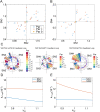Control of tissue homeostasis, tumorigenesis, and degeneration by coupled bidirectional bistable switches
- PMID: 34797839
- PMCID: PMC8641876
- DOI: 10.1371/journal.pcbi.1009606
Control of tissue homeostasis, tumorigenesis, and degeneration by coupled bidirectional bistable switches
Abstract
The Hippo-YAP/TAZ signaling pathway plays a critical role in tissue homeostasis, tumorigenesis, and degeneration disorders. The regulation of YAP/TAZ levels is controlled by a complex regulatory network, where several feedback loops have been identified. However, it remains elusive how these feedback loops contain the YAP/TAZ levels and maintain the system in a healthy physiological state or trap the system in pathological conditions. Here, a mathematical model was developed to represent the YAP/TAZ regulatory network. Through theoretical analyses, three distinct states that designate the one physiological and two pathological outcomes were found. The transition from the physiological state to the two pathological states is mechanistically controlled by coupled bidirectional bistable switches, which are robust to parametric variation and stochastic fluctuations at the molecular level. This work provides a mechanistic understanding of the regulation and dysregulation of YAP/TAZ levels in tissue state transitions.
Conflict of interest statement
The authors have declared that no competing interests exist.
Figures





Similar articles
-
A YAP/TAZ-induced feedback mechanism regulates Hippo pathway homeostasis.Genes Dev. 2015 Jun 15;29(12):1271-84. doi: 10.1101/gad.262816.115. Genes Dev. 2015. PMID: 26109050 Free PMC article.
-
MAML1/2 promote YAP/TAZ nuclear localization and tumorigenesis.Proc Natl Acad Sci U S A. 2020 Jun 16;117(24):13529-13540. doi: 10.1073/pnas.1917969117. Epub 2020 Jun 1. Proc Natl Acad Sci U S A. 2020. PMID: 32482852 Free PMC article.
-
Multifaceted regulation and functions of YAP/TAZ in tumors (Review).Oncol Rep. 2018 Jul;40(1):16-28. doi: 10.3892/or.2018.6423. Epub 2018 May 8. Oncol Rep. 2018. PMID: 29749524 Free PMC article. Review.
-
The Hippo pathway effector proteins YAP and TAZ have both distinct and overlapping functions in the cell.J Biol Chem. 2018 Jul 13;293(28):11230-11240. doi: 10.1074/jbc.RA118.002715. Epub 2018 May 25. J Biol Chem. 2018. PMID: 29802201 Free PMC article.
-
The essential role of TAZ in normal tissue homeostasis.Arch Pharm Res. 2021 Mar;44(3):253-262. doi: 10.1007/s12272-021-01322-w. Epub 2021 Mar 26. Arch Pharm Res. 2021. PMID: 33770379 Free PMC article. Review.
Cited by
-
Origin, heterogeneity, and interconversion of noncanonical bistable switches from the positive feedback loops under dual signaling.iScience. 2023 Mar 13;26(4):106379. doi: 10.1016/j.isci.2023.106379. eCollection 2023 Apr 21. iScience. 2023. PMID: 37034993 Free PMC article.
-
Mechanisms underlying divergent relationships between Ca2+ and YAP/TAZ signalling.J Physiol. 2023 Feb;601(3):483-515. doi: 10.1113/JP283966. Epub 2023 Jan 16. J Physiol. 2023. PMID: 36463416 Free PMC article.
References
Publication types
MeSH terms
LinkOut - more resources
Full Text Sources
Medical

